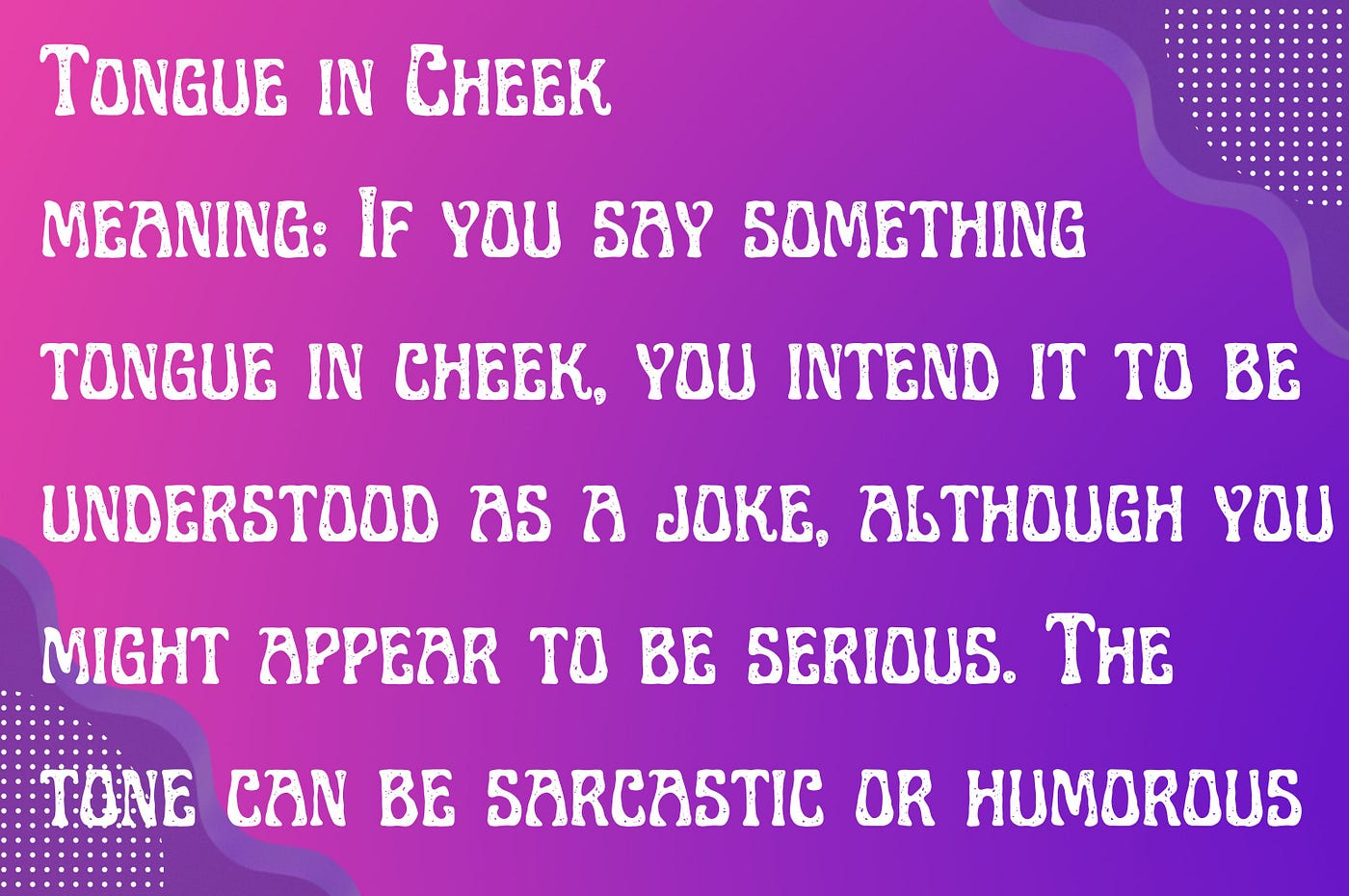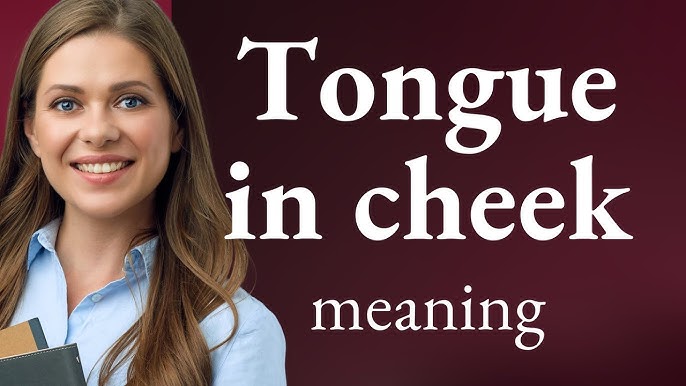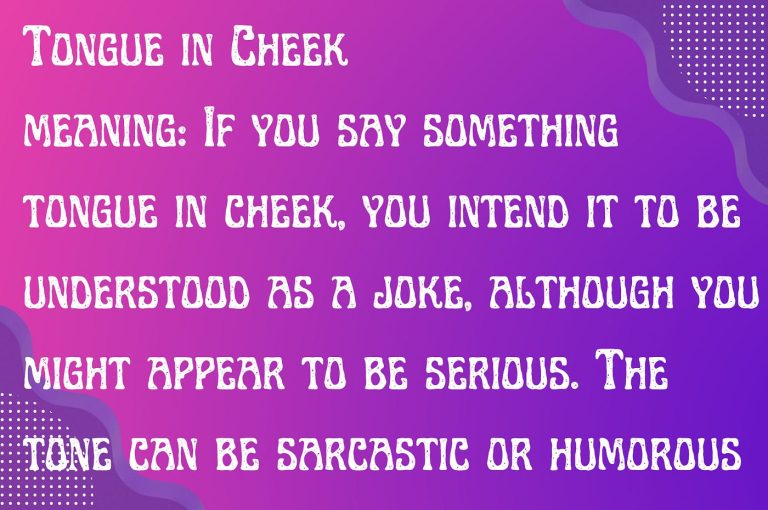The tongue in cheek meaning represents one of the most fascinating expressions in the English language. This phrase describes a way of speaking that’s playful, ironic, or sarcastic without being mean-spirited.
When someone speaks with their tongue in cheek, they’re not being completely serious about what they’re saying.
Understanding this expression helps you navigate conversations, literature, and media with greater sophistication.

What Does Tongue in Cheek Mean? (Featured Snippet Answer)
Tongue in cheek meaning refers to a form of humor or speech that is ironic, playful, or slightly sarcastic without being offensive or hurtful.
The speaker says something they don’t entirely mean, often with a humorous or teasing intention.
This expression indicates that the statement should not be taken at face value.
The Complete Definition of Tongue in Cheek
When we talk about tongue in cheek meaning, we’re discussing a specific type of communication style.
This phrase describes remarks made in a humorous, ironic, or mildly sarcastic way.
The speaker deliberately says something they don’t completely believe or mean literally.
It’s different from outright sarcasm because it’s gentler and more playful.
Think of it as a wink in verbal form – you’re letting people know you’re not being 100% serious.
The tongue in cheek approach often involves:
- Mild irony without malice
- Playful teasing or humor
- Statements that shouldn’t be taken literally
- A light-hearted tone despite serious-sounding words
- Subtle humor that requires some understanding to catch
Origins and Etymology of Tongue in Cheek
- The fascinating history behind tongue in cheek meaning dates back centuries.
- This expression has roots in 18th-century England, though its exact origins remain debated among linguists.
- The phrase likely comes from the physical act of pressing one’s tongue against the inside of their cheek.
- This gesture was historically used to signal that someone was being playful or not entirely serious.
Historical Development
- The earliest recorded use of “tongue in cheek” appeared in English literature during the 1700s.
- Writers used this expression to indicate when characters were speaking ironically or humorously.
- The phrase gained popularity throughout the 19th century in both British and American English.
- By the 20th century, tongue in cheek had become a standard expression in conversational English.
Cultural Significance
- Different cultures have similar expressions that convey the tongue in cheek meaning.
- The concept of playful irony exists across many languages and societies.
- This universality shows how important this type of communication is to human interaction.
How Tongue in Cheek Differs from Sarcasm
Many people confuse tongue in cheek meaning with pure sarcasm, but they’re different.
Sarcasm often carries a cutting edge or critical tone that can hurt feelings.
Tongue in cheek remarks are gentler and more playful in nature.
Key Differences:
Sarcasm:
- Often has a sharp, cutting tone
- Can be mean-spirited or hurtful
- Usually obvious in its intent
- May damage relationships if overused
Tongue in Cheek:
- Maintains a playful, light tone
- Rarely intended to hurt feelings
- Often subtle and requires interpretation
- Builds rapport when used appropriately
The tongue in cheek approach focuses on humor rather than criticism.
It’s about creating a moment of shared understanding rather than making someone feel bad.
Common Examples of Tongue in Cheek Expressions
Understanding tongue in cheek meaning becomes easier with real-world examples.
Here are situations where this expression commonly appears:
In Everyday Conversations
- When your friend arrives 30 minutes late and says, “I’m always so punctual,” that’s tongue in cheek.
- A parent might say, “Oh, I just love cleaning up after you,” while picking up toys.
- Someone might comment, “Sure, I’m a fantastic cook,” after burning dinner.
In Media and Entertainment
- Television shows often use tongue in cheek humor to connect with audiences.
- Comedy writers employ this technique to create subtle jokes that reward attentive viewers.
- News anchors sometimes use tongue in cheek remarks to add levity to serious topics.
In Literature
- Authors frequently use tongue in cheek meaning to create irony in their writing.
- This technique allows writers to criticize society while maintaining plausible deniability.
- Classic literature is full of characters who speak with tongue in cheek.
The Psychology Behind Tongue in Cheek Communication
The tongue in cheek meaning connects to deeper psychological principles of human communication.
This type of expression serves multiple social and emotional functions.
Social Bonding
- Using tongue in cheek humor creates a sense of shared understanding between people.
- It establishes an “insider” feeling among those who understand the joke.
- This builds stronger relationships and social connections.
Emotional Protection
- Speaking with tongue in cheek allows people to express opinions without full commitment.
- If someone takes offense, the speaker can claim they were “just joking.”
- This provides emotional safety in potentially sensitive conversations.
Cognitive Engagement
- Understanding tongue in cheek meaning requires active mental processing.
- Listeners must interpret the speaker’s true intent beyond the literal words.
- This creates more engaging and memorable communication experiences.
Regional and Cultural Variations
The tongue in cheek meaning varies significantly across different cultures and regions.
Understanding these differences is crucial for effective cross-cultural communication.
British vs. American Usage
- British English speakers use tongue in cheek expressions more frequently than Americans.
- The British tend to appreciate subtler forms of irony and understatement.
- American usage often requires more obvious signals to indicate tongue in cheek intent.
International Perspectives
- Different cultures have varying comfort levels with ironic communication.
- Some societies view tongue in cheek remarks as potentially disrespectful.
- Others embrace this communication style as sophisticated and witty.

How to Recognize Tongue in Cheek Remarks
Identifying tongue in cheek meaning requires attention to multiple communication cues.
Verbal Indicators:
- Slight emphasis on certain words
- Pauses before or after key phrases
- Tone that doesn’t match the content
- Exaggerated delivery style
Non-Verbal Signals:
- Subtle facial expressions
- Eye contact patterns
- Body language that contradicts words
- Timing of gestures
Contextual Clues:
- Relationship between speaker and audience
- Current situation or environment
- Previous conversation topics
- Cultural background of participants
Using Tongue in Cheek Effectively
Mastering tongue in cheek meaning in your own communication requires practice and sensitivity.
Best Practices:
Know Your Audience:
- Consider the other person’s personality and sense of humor
- Adjust your approach based on cultural background
- Be more direct with people who might not understand subtlety
Choose Appropriate Timing:
- Avoid tongue in cheek remarks during serious discussions
- Use this technique when the mood is already light
- Consider the emotional state of your audience
Practice Moderation:
- Don’t overuse tongue in cheek expressions
- Balance ironic remarks with genuine communication
- Ensure your intent is clear when necessary
Common Mistakes and Misunderstandings
Many people struggle with tongue in cheek meaning, leading to communication problems.
Frequent Errors:
Over-Subtlety:
- Making remarks too subtle for others to understand
- Assuming everyone will “get” your humor
- Failing to provide enough context clues
Wrong Timing:
- Using tongue in cheek during inappropriate moments
- Employing irony when people expect sincerity
- Misreading the mood of your audience
Cultural Insensitivity:
- Assuming your communication style works everywhere
- Ignoring cultural differences in humor appreciation
- Failing to adapt to international audiences
The Role of Tongue in Cheek in Modern Communication
Digital communication has significantly impacted tongue in cheek meaning and usage.
Social Media Impact:
- Online platforms make tongue in cheek expressions more challenging to convey.
- Without vocal tone and facial expressions, ironic intent often gets lost.
- Many social media misunderstandings stem from misinterpreted tongue in cheek remarks.
Text Messaging Challenges:
- Short message formats reduce the context needed for tongue in cheek communication.
- Emoji and punctuation marks attempt to replace vocal and visual cues.
- Younger generations develop new ways to signal ironic intent through digital means.
Professional Communication:
- Workplace emails and messages require careful consideration of tongue in cheek usage.
- Professional settings often demand more direct communication styles.
- Misunderstandings can have serious consequences in business contexts.
Teaching Tongue in Cheek to Non-Native Speakers
The tongue in cheek meaning presents unique challenges for language learners.
Learning Difficulties:
Cultural Barriers:
- Different cultures have varying relationships with irony
- Some languages lack direct equivalents for tongue in cheek expressions
- Cultural contexts affect interpretation significantly
Language Complexity:
- Requires advanced understanding of tone and context
- Depends on cultural knowledge beyond basic vocabulary
- Involves subtle linguistic cues that textbooks rarely cover
Teaching Strategies:
Contextual Learning:
- Use real-world examples from movies and TV shows
- Practice with native speakers in informal settings
- Explain cultural background behind expressions
Progressive Difficulty:
- Start with obvious examples before moving to subtle ones
- Provide clear explanations of when tongue in cheek is appropriate
- Practice identifying signals in various communication contexts
Tongue in Cheek in Different Professions
Various professional fields use tongue in cheek meaning in unique ways.
Entertainment Industry:
- Comedians rely heavily on tongue in cheek delivery for their performances.
- Actors must master this technique to portray characters effectively.
- Writers use tongue in cheek to create memorable dialogue and narration.
Journalism and Media:
- News commentators often employ tongue in cheek remarks to maintain objectivity while expressing opinions.
- Editorial writers use this technique to criticize without appearing overly harsh.
- Sports commentators frequently use tongue in cheek humor to entertain audiences.
Education:
- Teachers use tongue in cheek expressions to connect with students while maintaining authority.
- This approach helps create a relaxed learning environment.
- Students often respond positively to appropriate use of ironic humor.
Practical Exercises for Mastering Tongue in Cheek
Developing skill with tongue in cheek meaning requires deliberate practice.
Daily Practice Activities:
Observation Exercises:
- Watch comedy shows and identify tongue in cheek moments
- Listen to conversations and note ironic expressions
- Read articles and books that use this technique
Practice Scenarios:
- Role-play conversations with friends
- Practice appropriate timing and delivery
- Experiment with different levels of subtlety
Self-Assessment:
- Record yourself using tongue in cheek expressions
- Ask friends for feedback on your communication style
- Monitor how others respond to your ironic remarks

Advanced Applications of Tongue in Cheek
Sophisticated users of tongue in cheek meaning can employ advanced techniques.
Layered Irony:
- Create multiple levels of meaning within a single statement.
- This challenges listeners to think more deeply about your intent.
- Advanced users can convey complex ideas through seemingly simple remarks.
Contextual Mastery:
- Skilled communicators adapt their tongue in cheek style to different situations.
- They read their audience and adjust their approach accordingly.
- This flexibility makes their communication more effective and appropriate.
Cultural Bridge-Building:
- Expert users can employ tongue in cheek to connect across cultural differences.
- They find common ground through shared appreciation of subtle humor.
- This builds relationships and understanding between diverse groups.
Common Phrases with Tongue in Cheek Meaning
Many everyday expressions carry tongue in cheek connotations.
Popular Examples:
“Oh, wonderful!” (when something goes wrong) “Just perfect!” (when facing a problem) “Exactly what I needed!” (when encountering inconvenience) “How delightful!” (when experiencing something unpleasant)
Context-Dependent Phrases:
“Thanks a lot” (can be genuine or tongue in cheek) “Great job” (meaning depends on tone and situation) “Well done” (requires context to determine intent) “Fantastic” (interpretation varies with delivery)
The Impact of Tongue in Cheek on Relationships
Understanding tongue in cheek meaning significantly affects personal relationships.
Positive Effects:
Strengthened Bonds:
- Creates shared humor experiences
- Builds understanding between people
- Adds playfulness to interactions
Conflict Resolution:
- Provides a gentler way to address issues
- Reduces tension in difficult conversations
- Allows face-saving opportunities
Potential Challenges:
Misunderstandings:
- Can lead to hurt feelings if misinterpreted
- May create confusion about true intentions
- Requires mutual understanding to work effectively
Relationship Strain:
- Overuse can make someone seem insincere
- Cultural differences may cause problems
- Timing issues can damage trust
Tongue in Cheek in Literature and Arts
Creative works frequently employ tongue in cheek meaning for artistic effect.
Literary Applications:
- Authors use this technique to create complex characters and narratives.
- Tongue in cheek expressions add depth and nuance to dialogue.
- Readers must actively engage to fully understand the author’s intent.
Performing Arts:
- Actors must master tongue in cheek delivery to portray characters effectively.
- Directors use this technique to create memorable and engaging performances.
- Audiences appreciate the intellectual challenge of interpreting subtle humor.
Visual Arts:
- Artists incorporate tongue in cheek concepts into their work.
- This creates multiple layers of meaning and interpretation.
- Viewers must engage actively to fully appreciate the artistic intent.
FAQs
What is it called to be tongue-in-cheek?
It means being ironic, sarcastic, or joking in a dry, understated way. The speaker doesn’t intend to be taken literally.
What is another word for tongue-in-cheek?
Synonyms include ironic, facetious, sarcastic, wry, or dry-humored, depending on tone and context.
How do you use “tongue in one’s cheek” in a sentence?
Example: “His comment about quitting his job to become a pirate was clearly tongue-in-cheek.”
What does putting your tongue on the inside of your cheek mean?
Physically, it may suggest hesitation or thought. Figuratively, it hints that what you’re saying is not serious or is ironic.
Why do we say tongue-in-cheek?
The phrase comes from 18th–19th century English to suggest hidden sarcasm or mockery, as if suppressing a laugh.
How to use tongue-in-cheek?
Use it to describe speech or writing that’s meant to be humorous or ironic, but stated in a serious tone—often misunderstood by the literal-minded.
Conclusion
The tongue in cheek meaning represents a sophisticated form of human communication that enriches our interactions.
This expression allows us to convey complex ideas through playful irony and subtle humor.
Understanding and using tongue in cheek effectively requires cultural awareness, timing, and sensitivity to your audience.
As digital communication continues to evolve, mastering this technique becomes increasingly valuable for building meaningful connections.
Whether you’re navigating professional relationships, enjoying entertainment, or simply having conversations with friends, recognizing tongue in cheek expressions enhances your communication skills.
The key to success lies in practice, observation, and maintaining awareness of how others interpret your words.
Remember that tongue in cheek communication should always aim to connect rather than divide, to entertain rather than hurt, and to create understanding rather than confusion.
By mastering this art form, you’ll become a more effective and engaging communicator in all areas of your life.

